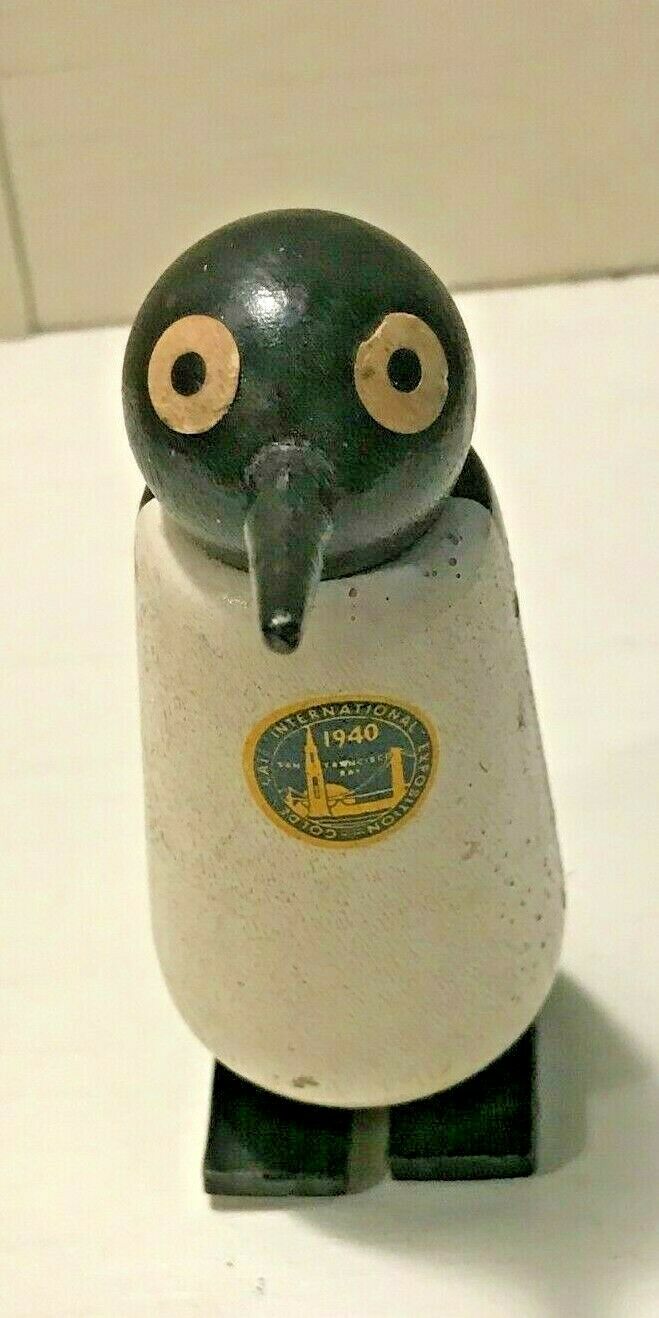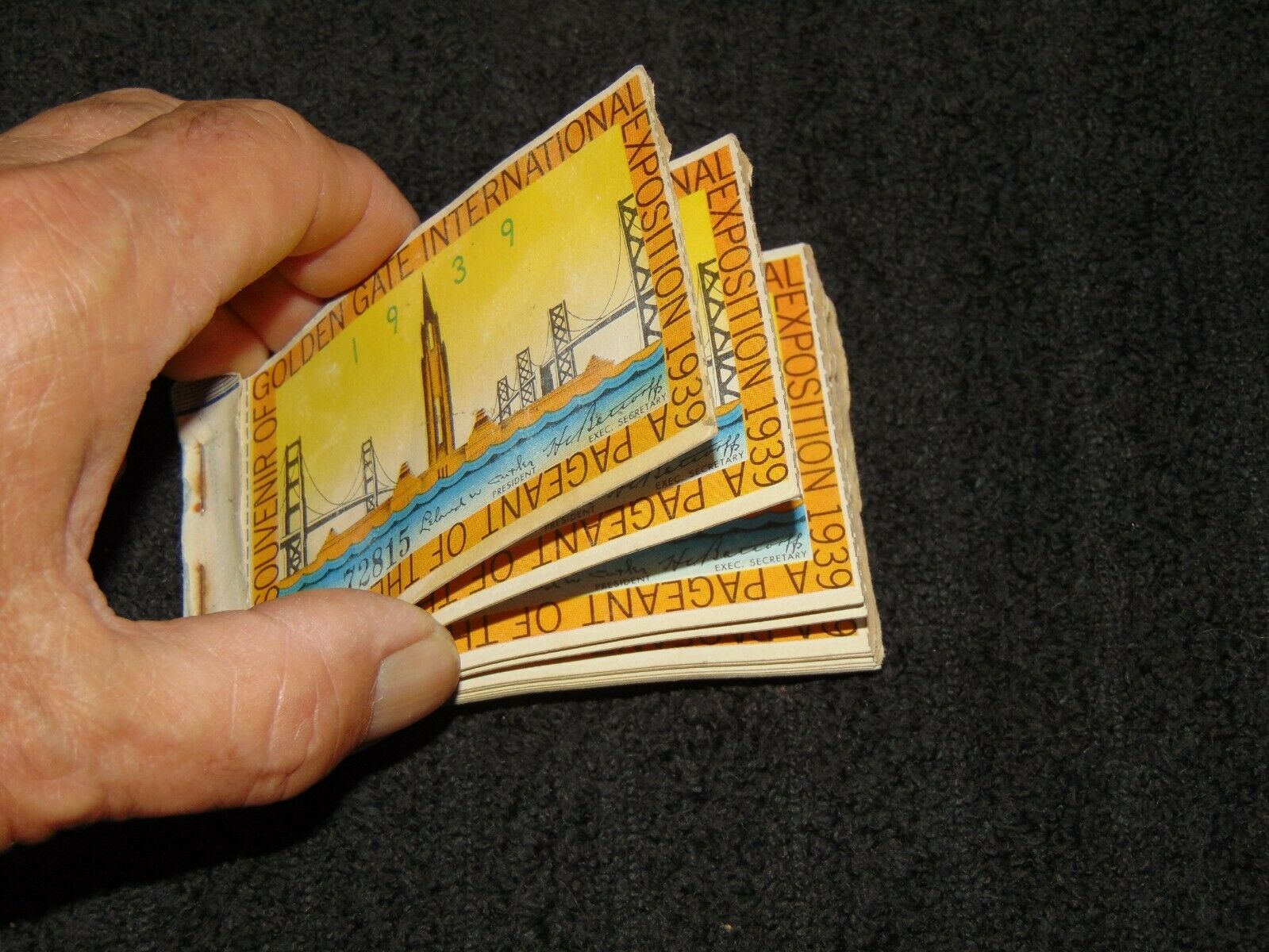-40%
1940 SAN FRANCISCO Golden Gate Exposition EXPO Decal GREYHOUND BUS California
$ 7.91
- Description
- Size Guide
Description
GOLDEN GATE EXPO DECALFREE SHIPPING with delivery confirmation on all domestic purchases!
Original 3-3/4" decal, "San Francisco Golden Gate Exposition 1940 by Greyhound"
We ship worldwide! Please see all pictures and visit
our eBay store and other eBay auctions!
The Golden Gate International Exposition (GGIE) (1939 and 1940), held at San Francisco's Treasure Island, was a World's Fair celebrating, among other things, the city's two newly built bridges. The San Francisco–Oakland Bay Bridge opened in 1936 and the Golden Gate Bridge in 1937. The exposition opened from February 18, 1939, through October 29, 1939, and from May 25, 1940, through September 29, 1940.
The idea to hold a World's Fair to commemorate the completion of the Bay Bridge and Golden Gate Bridge started from a letter to The San Francisco News in February 1933.[1] Architects W.P. Day and George Kelham were assigned to consider the merits of potential sites around the city, including Golden Gate Park, China Basin, Candle Stick Point, and Lake Merced.[2] By 1934, the choice of sites had been narrowed to the areas adjoining the two bridges: either "an island built up from shallow water" north of Yerba Buena Island which would go on to be named Treasure Island, or the Presidio, which had previously been used in 1915 for the Panama–Pacific International Exposition.[3] Yerba Buena Shoals was chosen as the site in February 1935.[4] In August 1935, a million proposal using federal WPA funds for construction work was advanced,[5] and in October of that year, Leland W. Culter, president of San Francisco Bay Exposition, Inc., announced that President Roosevelt had approved US,000,000 (equivalent to ,550,000 in 2017) to help fund the cost of reclaiming land at Yerba Buena Shoals.[6]
San Francisco Bay Exposition was incorporated on July 24, 1934.[4]
Initial schedules called for the fair to open on February 18, 1939, and to close on December 2, 1939, hosting a projected attendance of 20,000,000 people. Construction would employ 3,000, and running the fair would require a workforce of 10,000.[7]
Treasure Island
Main article: Treasure Island, San Francisco
Treasure Island, a flat, geometrically-shaped, artificial island attached to Yerba Buena Island, was built for the Exposition near where the Oakland span and the San Francisco span of the Bay Bridge join. The dredging of Treasure Island started on February 11, 1936.[8][9] 19,000,000 cu yd (15,000,000 m3) of fill were required for the 385-acre (156 ha) site.[10] Initial schedules called for the completion of dredging by the end of 1936.[7]
Built by the federal government, Treasure Island was intended to serve as the municipal airport for San Francisco, an idea which had first been advanced in 1931.[11] Air service would have included Pan American's transpacific flying boats, like the China Clipper. Due to wartime needs, it was taken over by the US Navy as Naval Station Treasure Island from 1941 to 1997.[12]
First closing
The fair closed on October 29, 1939,[13] and efforts to reopen the fair in 1940 were initially abandoned in December 1939.[14]
Attractions
Pageant of the Pacific
1939 U.S. commemorative stamp featuring the Tower of the Sun
The theme of the exposition was "Pageant of the Pacific", as it showcased the goods of nations bordering the Pacific Ocean. The theme was physically symbolized by "The Tower of the Sun", by an 80-foot statue of Pacifica, goddess of the Pacific ocean, and by architect Mark Daniels' Chinese village.[15]
As the boundaries of human intercourse are widened by giant strides of trade and travel, it is of vital import that the bonds of human understanding be maintained, enlarged and strengthened rapidly. Unity of the Pacific nations is America's concern and responsibility; their onward progress deserves now a recognition that will be a stimulus as well.
Washington is remote from the Pacific. San Francisco stands at the doorway to the sea that roars upon the shores of all these nations, and so to the Golden Gate International Exposition I gladly entrust a solemn duty. May this, America's World's Fair on the Pacific in 1939, truly serve all nations in symbolizing their destinies, one with every other, through the ages to come.
— President Franklin D. Roosevelt, via radio, during the opening ceremonies.[16]>
The San Francisco Downtown Association created the 49-Mile Scenic Drive to promote the exposition and the city. The drive started at San Francisco City Hall and ended on Treasure Island after winding around the "City by the Bay."
Architecture
W.P. Day, a locally prominent architect, was appointed director of works and George W. Kelham served as the chief architect until his death in October 1936, when he was succeeded by Arthur Brown Jr.[17]
Fine arts
During the Expo in 1939, Master carver John Wallace (Haida) demonstrated the art of carving totem poles for visitors.[18]
The Art in Action exhibition was staged at GGIE during its second session in the summer of 1940 to show artists at work and attract visitors.
The 1939 NCAA Basketball Tournament
As part of the exposition, the California Coliseum, located near the grounds' northeast corner, hosted the Western Regional Semifinal and Final rounds of the first-ever NCAA Division I Men's Basketball Tournament. The Coliseum, listed in NCAA guidebooks as having a capcity of 9,476,[19] hosted two Elite Eight games and a Final Four game (before 1952, there were only two regions and the champions won in the National Championship game, which was the only game played at what is now considered a "Final Four" site). The Western regional included the Oklahoma Sooners, Oregon Ducks, Texas Longhorns and the Utah State Aggies. In the Regional Semifinal round (now referred to as the Elite Eight), the Ducks beat the Longhorns 56-41 and the Sooners beat the Aggies 50-39. In the Regional Final round (now known as the National Semifinal round), the Ducks beat the Sooners 55-37, advancing to the National Championship game in Evanston, Illinois, where they would win the first ever national championship 46-30 against the Ohio State Buckeyes. There was also a regional third place game played in the Coliseum, which was won by the Aggies, 51-49.
Gayway
The "Gayway" at the Golden Gate International Exhibition, photographed here at night in 1940 by Charles Cushman, hosted numerous sideshow-style attractions, including "Sally Rand's Nude Ranch" (neon sign, at left), a burlesque show.
The GGIE "Gayway" at night (1940)
The GGIE featured a 40-acre (16 ha) midway named the "Gayway" after a contest was held in 1938 to name the Amusement Zone.[20]
One of the more successful attractions in the Gayway featured Sally Rand, who starred in "Sally Rand's Nude Ranch" (styled as "Sally Rand's NDude Ranch"); a contemporary publicity postcard shows Rand posing with female ranch hands, called "Nudies", as strategically-placed fence boards conceal implied nudity.[21][22] Other Gayway sights included sideshow-style attractions, such as little people in a Western setting and a racetrack featuring monkeys driving automobiles.[23]
Transportation
The Atchison, Topeka and Santa Fe Railway started a passenger train, the Valley Flyer, to carry passengers between Bakersfield and Oakland during the exposition.[24] The Chicago, Burlington, and Quincy Railroad, Denver and Rio Grande Western Railroad, and the Western Pacific Railroad launched the Exposition Flyer passenger service between Chicago and Oakland, named for the Golden Gate International Exposition.[25]
Legacy
In October 2010, the National Building Museum in Washington, D.C. opened an exhibition titled Designing Tomorrow: America’s World’s Fairs of the 1930s.[26] This exhibition, which was available for view until September 2011, prominently featured the Golden Gate International Exposition.
Many of the art pieces that were created from the Art in Action exhibition, including the Pan American Unity mural by Diego Rivera, three Dudley C. Carter wood carvings, and two Frederick E. Olmsted sculptures are now housed and displayed at City College of San Francisco.[27]
The Fauna and Flora of the Pacific mural by Miguel Covarrubias is now on display at the de Young museum in San Francisco. The colorful and oversized map depicts the four Pacific Rim continents with examples of their flora and fauna suspended in a swirling Pacific Ocean populated with sea creatures.[28]
See also
Art in Action, the live art exhibition that took place at the GGIE
Panama-Pacific International Exposition (1915 San Francisco World's Fair)
Pan American Unity mural
Official Guide Book[29]
The Magic City, Treasure Island, 1939-1940[30]
_______________________________________________________________
Why Buy From Chestnut Hill Books?
Chestnut Hill Books has a perfect 100% feedback rating dating over 18 years and spanning 20,000+ transactions, with customers in all 50 states and over 100 countries on 6 continents. Our detailed seller ratings (item as described, communication, shipping time and shipping and handling charges) are among the best on eBay. All domestic purchases come with free shipping and complimentary delivery confirmation, trackable through
the United States Post Office.
Thank you for looking at our items!
Payment:
Payment is due within 7 days of purchase. Contact us
for special payment requests/options. If payment cannot be produced within the 7 day period, please send a message immediately indicating when payment should be expected, otherwise an unpaid item dispute will be filed with eBay.
Where Do We Ship?
Chestnut Hill Books ships to every country in the world at reasonable rates as suggested by the United States Postal Service.
Please contact us for a specific international shipping quote before bidding should you have any questions.
Shipping Terms:
If payment is made immediately, your item will usually be mailed within 24 hours of payment receipt.
All items are securely packed to ensure safe shipping. Postcards are mailed between sturdy cardboard. All domestic shipments come with complimentary delivery confirmation, trackable through
the USPS
. Buyers will receive an e-mail from PayPal with tracking information and related links; please refer to this e-mail before contacting us with questions on the status of your package, as we will have as much delivery information as you. Zero profit is made on international shipping & handling charges; domestic shipping is free.
Return Policy:
We strive to describe each item completely and accurately. However, if you feel an item was not described correctly, the item can be returned at our expense within 30 days of receipt for a refund of your original payment. It is requested that you contact us immediately
should you have any question about the condition or representation of your item.
Who Are We?
Chestnut Hill Books is a family-owned antiques business based out of the SouthCoast, Massachusetts. We collect historical items related to New Bedford, Massachusetts and the surrounding area (Dartmouth, Fairhaven, Westport etc), Boston College (tickets, programs, pennants, postcards, scrapbooks, pinbacks, sports & non-sports etc), Massachusetts political buttons & memorabilia and Mount Monadnock in Jaffrey, New Hampshire. Please contact us if you have any collectibles in those categories.
Other:
Please do not hesitate to contact us with any other questions/comments. We normally respond to all inquiries in a timely manner. Also, please do not forget to leave positive feedback upon item receipt! Thank you for looking at our listings!
_______________________________________________________________









